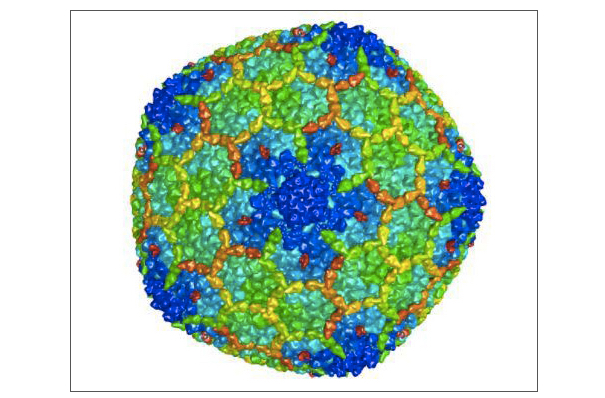
A neuron’s genetic material can literally “go viral.” The genetic material, messenger RNA (mRNA) from the Arc gene, can be passed from neuron to neuron via extracellular vesicles and capsids, rather like retroviral RNA. This finding, which emerged from two recent studies, helps explain why the Arc protein shares features with proteins found in certain viruses like human immunodeficiency virus (HIV). Apparently, infectious retroelements have been repurposed during evolution to do something useful—mediate cell-to-cell communication in the nervous system.
The Arc gene is known to play a vital role in synaptic plasticity and the brain’s ability to store new information. Still, little is known about how the Arc gene works. To investigate the Arc gene’s molecular function and evolutionary origins, scientists based at the University of Utah introduced it into bacterial cells. To their surprise, when the cells made the Arc protein, the protein clumped together into a form that resembled a viral capsid, the shell that contains a virus' genetic information. The Arc “capsids” appeared to mirror viral capsids in their physical structure as well as their behavior and other properties.
“Beforehand, if I had said to any neuroscientist that this gene sort of acts like a virus, they would have laughed at me,” said Jason Shepherd, Ph.D., an assistant professor at the University of Utah. “We knew this was going to take us in a completely new direction.”
Dr. Shepherd and colleagues presenting their findings in an article (“The Neuronal Gene Arc Encodes a Repurposed Retrotransposon Gag Protein that Mediates Intercellular RNA Transfer”) that appeared January 11 in the journal Cell. In this article, the scientists explained that endogenous Arc protein is released from neurons in extracellular vesicles that mediate the transfer of Arc mRNA into new target cells, where it can undergo activity-dependent translation.
“Purified Arc capsids are endocytosed and are able to transfer Arc mRNA into the cytoplasm of neurons,” wrote the article’s authors. “These results show that Arc exhibits similar molecular properties to retroviral Gag proteins.”
These findings were complemented by work accomplished by an independent team of scientists based at the University of Massachusetts Medical School. These scientists set out to scrutinize the contents of extracellular vesicles released by cells. Their experiments in fruit flies revealed that motor neurons that control the flies' muscles release vesicles containing a high concentration of the Arc gene's mRNA.
The Massachusetts group presented their findings in an article (“Retrovirus-like Gag Protein Arc1 Binds RNA and Traffics across Synaptic Boutons”) that also appeared January 11 in Cell. This article reported that the Drosophila Arc1 protein forms capsid-like structures that bind darc1 mRNA in neurons and is loaded into extracellular vesicles that are transferred from motor neurons to muscles.
“This loading and transfer depends on the darc1-mRNA 3′ untranslated region, which contains retrotransposon-like sequences,” the article’s authors wrote. “Disrupting transfer blocks synaptic plasticity, suggesting that transfer of dArc1 complexed with its mRNA is required for this function.”
The Massachusetts group, like the Utah group, found evidence that Arc capsids contain Arc mRNA and that the capsids are released from extracellular vesicles that are released by neurons. In addition, Dr. Shepherd's team showed that the more active neurons are, the more of those vesicles they release.
Further experiments performed by both teams of researchers suggested that Arc capsids act like viruses by delivering mRNA to nearby cells. Dr. Shepherd and his colleagues grew mouse neurons lacking the Arc gene in petri dishes filled with Arc-containing vesicles or Arc capsids alone. They discovered that the formerly Arc-less neurons took in the vesicles and capsids and used the Arc mRNA contained within to produce the Arc protein themselves. Finally, just like neurons that naturally manufacture the Arc protein, those cells made more of it when their electrical activity increased.
The UMass researchers, meanwhile, showed that Arc mRNA and capsids travel only in a single direction between fly cells—from motor neurons to muscles—and that the Arc protein binds to a specific part of the Arc mRNA molecule, called the untranslated region, that is not used to make the Arc protein. They also found that flies lacking the Arc gene form fewer connections between their motor neurons. Moreover, while normal flies create more of these connections when their motor neurons are more active, flies without the Arc gene failed to do so.
Both groups of scientists now plan to investigate why cells use this virus-like strategy to shuttle Arc mRNA between cells and whether this system might allow the toxic proteins responsible for Alzheimer's disease to spread through the brain. The leader of the Massachusetts team, Prof. Vivian Budnik, Ph.D., hopes that such research will shed light on the development of neurological diseases and potentially lead to new therapies.
In addition, Dr. Shepherd believes it may be possible to use Arc capsids for genetic engineering and gene therapy, which currently use viruses to introduce new genetic instructions into cells. The human immune system sometimes attacks those viruses, causing dangerous side effects. Because the Arc protein is native to the human body, clinicians may be able to use Arc capsids to deliver genes for gene therapy without triggering an immune response.
“This research highlights the fact that we often don't know where the cool discoveries are going to come from,” Dr. Shepherd said. “We need to follow where the science takes us.”











